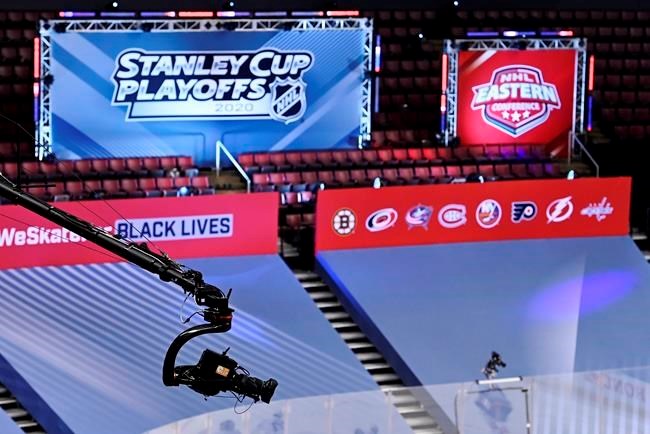TORONTO — There’s no ear-splitting cannon booming from the stands in Columbus every time the Blue Jackets score. Gritty, the Philadelphia Flyers mascot, isn’t parading through the arena. No one's firing up any sirens in Las Vegas.
As much as NHL chief of events and entertainment Steve Mayer would like to include those features, and so many others distinctive to the league’s markets, there is only so much he and his hundreds of staffers can do given the limitations of being inside the playoff hub-city bubbles in Toronto and Edmonton, Alberta.
That still hasn’t stopped the league from providing at least some tastes of home in empty arenas, with familiar sights and sounds of national anthem performers, goal songs and rink-board signage of local sponsors
“We came up with a general philosophy, and it was right from the beginning when we knew we were going to play at a neutral site,” Mayer said.
“It’s not going to be their arena, but you could do certain things that at least give them the feeling that they’re the home team,” he added. “So, we reached out to each team individually and told them, empty the whole bucket.”
From the Ramones’ “Blitzkrieg Bop,” to Jimmy Eat World’s “Sweetness” pounding through the PA systems, Toronto’s Scotiabank Arena has been made to resemble everyplace from Nassau Coliseum in Long Island, New York, to the Panthers' BB&T Center in Sunrise, Florida.
One of the drawbacks? The “visiting” team's songs get played, too.
“Weren’t we the home team?” Carolina forward Justin Williams wondered, referring to the New York Rangers following Carolina’s preliminary round series-opening 3-2 win. “Other than that, we had our music for a home game. We had music for warm-up.”
Mayer noted that goal songs — home or away — maintain a level of energy in the building.
“He’s the only that I’ve heard that has commented on it. And I find that to be pretty unbelievable actually” he said. “Now, as we get later in the rounds, do people start focusing on it a little more? Maybe. But we’ve been really happy with the reaction from the players.”
Though players’ views are important, Mayer’s approach to game presentation is more on how the action and atmosphere translates to a television audience.
It’s why the NHL elected to use the arena settings as more of a stage, with the focus placed on the ice. Tarping the seats in the lower bowl was an early decision made as opposed to following other sports’ leads in using cardboard cutouts of various personalities to create the illusion of fans.
Additional cameras were added, including one placed on a crane over
“It’s a Hollywood set,” Mayer said. “We’re producing one of the greatest made-for-TV events ever. And it’s all going to be about the drama on the ice.”
The NHL has continued experimenting with adding crowd noise, with the sounds of fans cheering and oooohing during a flurry of action, and the volume getting louder as the game progresses.
Capitals forward Garnet Hathaway said the only time he notices there are no fans in the building is when he can overhear what’s being discussed on the other team's bench.
“Other than that, when the game play’s going, it’s kind of business as usual,” Hathaway said. “They’re making it as real as much as possible without fans. They’re doing a good job, and it doesn’t seem that strange right now.”
Mayer expects the production will improve as the playoffs proceed, considering there was no blueprint.
“It is unprecedented, and when we look at what we’re doing on the screens, these are things that have never been done,” he said. “We’re going to make changes because we all are focused on how can it be a bit better. But I also have to admit, I’m very proud of what we’re doing.”
After no hockey for 4 1/2 months, no fans in the building and with Mayer and his staff confined to a bubble, things could be a lot worse.
___
AP Hockey Writer Stephen Whyno contributed to this story.
___
For more AP NHL coverage: https://apnews.com/NHL and https://twitter.com/AP_Sports
John Wawrow, The Associated Press



